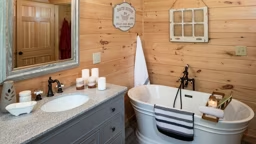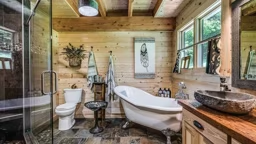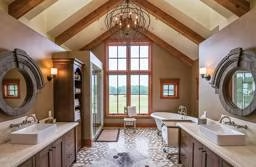For most of us, the master bath evokes powerful images. We envision a refuge filled with luxury amenities, spa-like fixtures and sophisticated style—a true oasis for the soul. To create such a paradise takes some careful planning, a dash of indulgence and balance. You need to weigh contemporary furnishings versus rustic, rough walls versus sleek tile, color and pattern versus plain and simple. Here are 15 design tips to help you conceive a bath that is a true showplace in your home and the tranquil haven of your dreams.
1. Wood Walls or Flat Walls?
When designing a master bath for a log home, the first thing you need to consider is whether you want to carry the log look into your bath or create a more conventional room with flat walls. Log walls will stay true to the theme of your home, but you may find it is harder to pick fixtures that work with the wood look. "There's a big difference between the rustic quality of logs and the sleek, contemporary look of bath fixtures today," explains interior designer Adrianne Dale. "This great disparity between the character of the materials calls for a matter of balance. You need to consider the scale or visual weight of the design of your fixtures; they need to be substantial enough to relate to the logs in the room or they will be overwhelmed by the logs." To help tie the room together, consider large-scale fixtures that echo the lines of your logs. If you're still trying to decide whether or not you should go with logs in your master bath, visit other log homes and take note of the way the master bath flows with the rest of the house. "Try to look at as many actual log homes as possible," says Adrianne. "Spend some time within the space to see if you will be comfortable with that much wood all around you."

This opalescent mosaic from New Ravenna has a design that echoes the pattern of wood grain.
2. Tile: Practical Yet Beautiful
Both practical and decorative, tile is perfect for creating a waterproof surface around showers, basins and baths. It also creates contrast and provides relief in a home that's otherwise filled with log walls. "Tile can be a great bridge between two types of materials," says Adrianne.
Once preferred for its practicality, tile has been elevated to an art form in recent years. Today's designs offer numerous options, from small, mosaic patterns to bold border motifs. Even the types of tile available are vast: ceramic, terra cotta, slate, granite and marble are just some of the choices. When selecting tile for your bath, choose the tile size and grout carefully. "The smaller the tile, the more grout lines you'll have, and the more grout you'll have to take care of," explains architect Jean Steinbrecher. "Also, the whiter the grout, the tougher it is to take care of. And white may be too stark against a log backdrop."
While keeping these practical concerns in mind, you still have an unlimited number of options when choosing tile. You can add interest to your design by using contrasting borders or insets. Also consider varying the theme by using fragments of tile to build up a larger mosaic pattern. Another option is to use tiles on a grand scale by setting large tile squares in a colorful checkerboard pattern. Whether you plan to use tiles on your bathroom floor or on your shower walls, it's smart to choose quality products since they'll hold up better over time. "Pay attention to your finish surfaces," Jean says. "Spend the extra money now for good quality. It is worth it in the long run."

up the space with more natural light. Photo: courtesy Pan Adobe Cedar Homes
3. Consider a Glass-Block Wall
Nothing adds drama to a master bath like a sparkling glass-block wall. Whether it's used to divide spaces or provide privacy in the shower, glass block lends instant sophistication. One of the best things about glass is its ability to reflect natural light. When set near a window, a glass wall will filter natural sunlight and create a romantic ambiance. Even windowless rooms can be enhanced with glass walls-the clear blocks will reflect the light within the room and make the space feel bigger.
The good news for those who've always dreamed of designing with glass block is that it may now be easier than ever. A number of companies now offer glass block systems that come with everything from the block to the shower base-- and they are easy enough for most do-it-yourselfers to assemble. If you'd like to incorporate glass on a smaller scale, consider glass vanity accessories that will bounce light back into the room. Glass towel bars and shelving are other options that bring the beauty of glass into your bathroom without involving major remodeling.
4. Mirrors Make a Style Statement
Among the most versatile accents in the bath, mirrors visually enlarge spaces while making a style statement. Their reflective qualities allow them to enhance the room's lighting, seemingly "doubling" its effect. Of course, mirrors meet practical needs as well; after all, the bath is the place for grooming. If positioned properly, a mirror can add the illusion of height or width to any setting. In a log bath, mirrors can reflect the beauty of the wood in the room. Many designers choose to position mirrors especially for this purpose.
5. Faucets: Top Taps
Faucet design has come a long way over the past few years as designers embrace more sophisticated and elegant shapes. In fact, just updating your faucets to one of the new designs can visually transform the room without the cost of a major renovation. Brass faucets are especially durable and eye-catching. Look for a design that speaks to you personally, even if it's a bit over the top; in a log bath, you can dare to be whimsical. When shopping for sink faucets, consider the size and shape of your lavatory basin. You don't want to overwhelm a small sink with an oversized fixture. In the shower, Jean recommends looking for a faucet with an anti-scald control. Coordinate your tub faucet with your lavatory faucet to create a sense of continuity.

mimics the dresser's woodwork pattern.
6. Use Repurposed Rustic Furniture
If you think furniture doesn't belong in the bathroom, think again. Today's home owners are incorporating handsome cabinets, tables, chairs and more into their master baths. In fact, one of the hottest trends is converting an old table or cabinet into a sink vanity. Designers cut a hole in the table and set in a washbasin, often utilizing wall-mounted fixtures to save space. You can also use furniture for storage. Add a stylish chest to give your bathroom an unexpected elegance while providing ample space for towels and toiletries. Or install a small bookshelf and fill it with bathroom containers and other accessories to free up space on your vanity. The key to incorporating furniture in the bath is moderation. One strong piece—such as a rustic chest—is much more effective than a crowded grouping of nondescript pieces.
7. Splurge on Fancy Fixtures
Tubs, toilets and showers are essential elements in any bath. If you're looking for a little luxury, there's no better place to splurge. In the master bath, spa-like fixtures, such as whirlpool tubs and saunas, are quickly becoming the norm. There are custom showers that can pamper you with built-in body jets and multiple body sprays. Steam showers are another popular choice, as are sunken whirlpool tubs. If you opt for a luxury tub, just be sure to incorporate some kind of backsplash to protect your log walls. In a log bath, color choice is important. For example, white fixtures may seem too contemporary for your setting. If so, consider bone-colored fixtures instead. Also, keep in mind that the color you choose will have to stand up over time. "When you're choosing fixtures, pick colors that won't become dated," advises Jean. "After all, these items are called fixtures because they are permanent." When shopping for fixtures, look for designs that echo the curves of your logs. Be sure to select fixtures that reflect your overall decorating theme: a traditional Victorian tub, for example, or a modern glass shower stall.

Photo: Courtesy Honest Abe Log Homes
8. Don't Neglect Your Lighting
Good lighting can turn a master bath into a masterpiece. After all, there's nothing worse than a dark, dreary bathroom. This is especially a concern in a log home. "Logs tend to absorb more light than a flat, painted surface," Adrianne cautions. Even if you opt to forgo logs in your master bath, good lighting is still essential. It may be difficult to decide where to place lights before you actually start using the room, but keep in mind that it's always better to over-light rather than under-light. At the very least, place lighting by your mirror, near the bath and overhead. And locate your lights carefully. To achieve the best effect around your mirror, for example, you want to place lights on each side, Jean says; overhead lighting is often too harsh. To further brighten your bath, you can add interior cabinet lights. Spotlights are another good option. You can train them onto logs or other architectural details that you want to bring into the limelight.
9. Consider Wallpaper
The mere thought of wallpaper in the bathroom causes many people to cringe. After all, the damp conditions and condensation will cause wallpaper to peel away, won't it? Not anymore. With the wide range of vinyl wallpapers on the market today, you no longer have to worry about moisture damaging your beautiful paper. Specially designed for bathroom use, these vinyl papers are available in a variety of designs and colors. If you decide to use wallpaper, don't feel obligated to cover all four walls, floor to ceiling. Some people just paper one or two walls as accents. A border is another great alternative to the full-wall treatment. Whether you paste the border around the top of your walls or at a chair-rail height, you're sure to enjoy the whimsical designs that are available. Don't be afraid to try something new. A border depicting cowboy boots, for example, is a fun way to add Western charm.

pop of color to this log home's
guest bathroom.
10. Windows
You can easily expand the experience in your master bath by incorporating a large picture window with a great view: Frame a scenic vista just beyond a sunken tub and you'll feel like you're one with nature every time you hop in for a soak. If you prefer privacy to a panoramic view, consider using textured glass or opaque glass instead. You'll still enjoy the beauty of glass-filtered sunlight, plus you'll have the added bonus of a unique design element in your master bath. Or, if it isn't possible to add a window, try "creating" a view. Browse local art shops for a landscape print that speaks to your senses, then frame the print in an old window frame. Be creative-try something a little out of the ordinary.
11. Over Head: Your Bathroom Ceiling
One of the most neglected areas in most master baths is the ceiling. Since it's not the place the eye is instantly drawn to, people often forget that ceilings have decorative powers all their own. But, when you lie back in the tub for your inaugural bubble bath, your bathroom ceiling will be the first thing you see. In a log home, the master bath ceiling is the perfect place to showcase beautiful logwork or hewn timbers.
If your bath is conventionally framed, you can still incorporate log beams or wood paneling into its ceiling design. As an alternative, you can apply a decorative paint treatment, such as sponging or stenciling. High ceilings seem to be popular with home owners today, but not every expert believes they are suitable for the bath. "The bath is not ideal for a cathedral ceiling; there is a level of comfort lacking," Jean says. "I recommend 9- to 10-foot ceilings. With a cathedral ceiling, moisture can easily get trapped up in there and sound reverberation can also be a problem." Of course, cathedral ceilings may be right for some log baths and not others. The key is to get your ideas down on paper and consider them carefully before construction begins.
12. Color Accents
If you live in a log home or you're in the process of building one, you've probably already discovered the essential role that color plays in your home decor. Being surrounded by so much wood is incredibly comforting, but you may need to add some color accents to break up the monotony of the wood tones. The master bathroom can benefit from color, too. Even if your bathroom isn't filled with logs, it's a good idea to jazz it up with vivid tones. "The more color, the better," Jean says. A great way to introduce color in the bath is with accessories and fabrics. A brilliant red shower curtain will contrast with the wood beams overhead. Deep blue vanity accessories will add a note of color confidence. A festive valance in a bright hue, colorful towels and glass bottles will all spice up the room.
13. Luxurious Bathroom Extras
A master bath is the epitome of luxury. This is the place to indulge—a space where you can unwind from the hectic pace of daily life. There's no better room to incorporate luxurious touches. For example, heated towel bars, which are already a trend in Europe, are quickly catching on in American baths. What could be more soothing than wrapping up in a toasty warm towel after showering on a chilly morning? Radiant-floor heating is another comforting feature. For log home owners who are accustomed to the warmth of wood floors, cold tile floors in the master bath can be a shock to the system. A heated tile floor is a perfect antidote, and one that will enhance your bath's sense of coziness. Some luxury touches also increase the convenience of your bath. Two examples: a built-in niche for soaps and shampoos in the shower and a built-in shower seat.
14. Details, Details
They may be the smallest elements in the room, but details play a huge role in determining the character of your master bath. Need proof? Take all the towels out of your bath and take a mental picture of the room; replace the towels and note the difference. Most likely, the change is more dramatic than you realized. In a log bathroom, details are especially important because you're aiming to create a sense of character in a small space that may already be filled with a lot of wood. To give your bath a special touch, pick distinctive hardware and vanity accessories. Of course, determining what accents work in your master bathroom is often a matter of trial-and-error. "The space looks very different in a log bath because of the curves of the timbers," says Adrianne. "Try to look at some actual log baths before you add accents to yours." And if you find the accessories you've chosen don't hold up over time, don't worry. The great thing about accessories is that you can easily change or replace them as your style shifts.

bathroom from Wisconsin Log Homes. Photo: courtesy Wisconsin Log Homes
15. Stonework
Since it's just a stone's throw away from the other rooms in your log home, your master bath should be tied into your overall decor. One way to do this is by echoing the stone presence found in other areas of the home. If you have a natural fieldstone fireplace in your great room, for example, you can incorporate the same fieldstone in your bath by using leftover stones to create a dynamic tub surround or an attractive wall border. If you have a tile floor in your bath, consider interspersing fieldstone into its design. If you love the mix of logs and stone but want something subtle, try adding just one or two stone accents in the bath, such as a flagstone wall clock or a stone countertop. The incorporation of stone—and other materials—is important because it helps to introduce textural variety. "You can use other materials in the room, and your logs still have a presence without being threatened by them," Jean explains.
If there's one thing that separates log home master baths from their counterparts in conventional homes, it's that there is more room for having decorating fun in log homes. Perhaps this is partly due to the fact that many log homes are built as vacation retreats, places where you can unwind and take life a little less seriously. Still, whether you design a year-round home or a weekend getaway, having a sumptuous master bath will make you feel like you're on vacation every day of the year.











